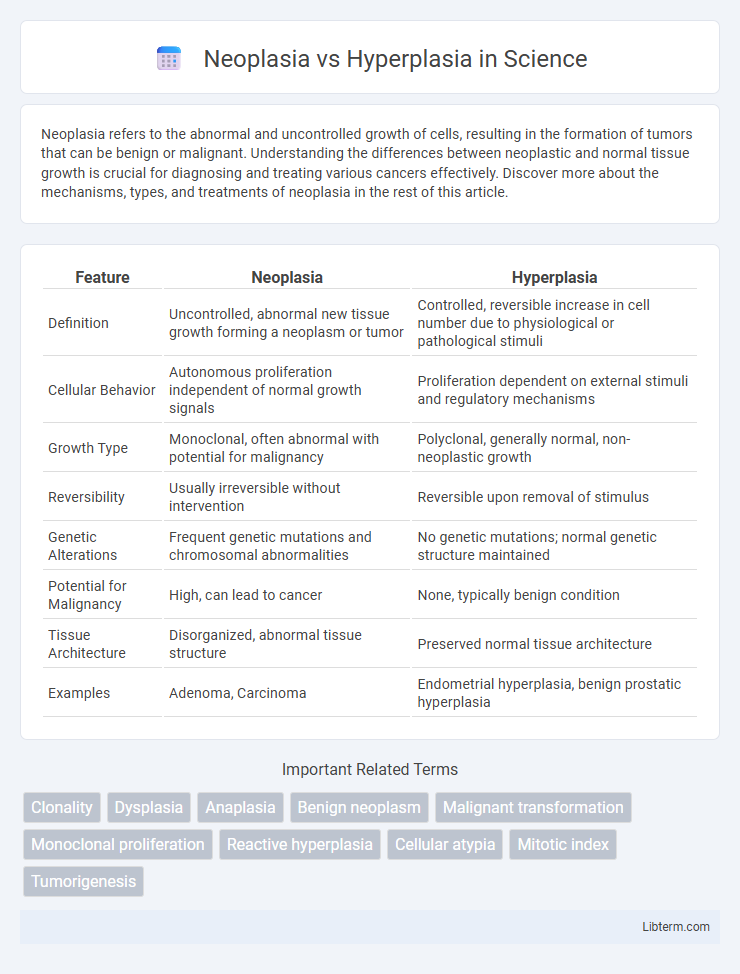Neoplasia refers to the abnormal and uncontrolled growth of cells, resulting in the formation of tumors that can be benign or malignant. Understanding the differences between neoplastic and normal tissue growth is crucial for diagnosing and treating various cancers effectively. Discover more about the mechanisms, types, and treatments of neoplasia in the rest of this article.
Table of Comparison
| Feature | Neoplasia | Hyperplasia |
|---|---|---|
| Definition | Uncontrolled, abnormal new tissue growth forming a neoplasm or tumor | Controlled, reversible increase in cell number due to physiological or pathological stimuli |
| Cellular Behavior | Autonomous proliferation independent of normal growth signals | Proliferation dependent on external stimuli and regulatory mechanisms |
| Growth Type | Monoclonal, often abnormal with potential for malignancy | Polyclonal, generally normal, non-neoplastic growth |
| Reversibility | Usually irreversible without intervention | Reversible upon removal of stimulus |
| Genetic Alterations | Frequent genetic mutations and chromosomal abnormalities | No genetic mutations; normal genetic structure maintained |
| Potential for Malignancy | High, can lead to cancer | None, typically benign condition |
| Tissue Architecture | Disorganized, abnormal tissue structure | Preserved normal tissue architecture |
| Examples | Adenoma, Carcinoma | Endometrial hyperplasia, benign prostatic hyperplasia |
Introduction to Neoplasia and Hyperplasia
Neoplasia refers to the abnormal and uncontrolled growth of cells, forming a neoplasm or tumor that can be benign or malignant, whereas hyperplasia is an increase in the number of normal cells in a tissue or organ, resulting in its enlargement without neoplastic transformation. Neoplastic growth is characterized by genetic mutations that lead to autonomous cell proliferation independent of normal regulatory mechanisms, while hyperplasia remains a regulated, reversible process driven by physiological or pathological stimuli. Understanding the distinction between neoplasia and hyperplasia is crucial for accurate diagnosis, prognostication, and treatment planning in clinical pathology.
Definition of Neoplasia
Neoplasia refers to the abnormal and uncontrolled proliferation of cells that leads to the formation of a neoplasm or tumor, which can be benign or malignant. Unlike hyperplasia, which is a reversible increase in the number of cells in response to a stimulus, neoplasia is characterized by autonomous growth independent of normal regulatory mechanisms. This uncontrolled growth results from genetic mutations affecting cell cycle regulation, leading to persistent and often irreversible cellular proliferation.
Definition of Hyperplasia
Hyperplasia is the increase in the number of cells within a tissue or organ, leading to its enlargement while maintaining normal cellular organization. Unlike neoplasia, which involves uncontrolled and abnormal cell growth forming tumors, hyperplasia is a regulated and reversible process often triggered by physiological stimuli or injury. Common examples include endometrial hyperplasia and benign prostatic hyperplasia, where cell proliferation remains under normal genetic control without malignant transformation.
Key Differences Between Neoplasia and Hyperplasia
Neoplasia involves uncontrolled, abnormal cell growth forming masses called tumors, which can be benign or malignant, unlike hyperplasia that is a controlled, reversible increase in cell number due to a physiological or pathological stimulus. Neoplastic cells typically display genetic mutations and a loss of normal growth regulation, while hyperplastic cells maintain normal cellular architecture and function. The key distinction lies in neoplasia's potential for invasion and metastasis, contrasting with hyperplasia's non-invasive, adaptive response.
Cellular Mechanisms Involved
Neoplasia involves uncontrolled cellular proliferation driven by genetic mutations affecting oncogenes and tumor suppressor genes, leading to autonomous growth independent of normal regulatory signals. Hyperplasia is characterized by an increased number of cells due to a physiological response to stimuli, involving reversible cell cycle activation mediated by growth factors and cytokines. Unlike hyperplasia, neoplastic cells exhibit altered apoptosis pathways and evade senescence, contributing to their persistent and unregulated expansion.
Causes and Risk Factors
Neoplasia arises from genetic mutations leading to uncontrolled cell growth, often triggered by carcinogens such as tobacco smoke, radiation, and viral infections like HPV. Hyperplasia results from increased cell proliferation in response to stimuli like chronic inflammation, hormonal imbalances, or injury, serving as an adaptive but reversible process. Risk factors for neoplasia include age, family history of cancer, and exposure to environmental toxins, whereas hyperplasia primarily stems from chronic irritation or hormonal changes without direct DNA damage.
Histopathological Features
Neoplasia is characterized by abnormal, uncontrolled cell proliferation forming a mass with histopathological features such as cellular atypia, pleomorphism, and mitotic figures, often with a loss of normal tissue architecture. Hyperplasia shows an increase in the number of cells within a tissue or organ, maintaining normal cellular morphology and tissue organization without atypical features or significant mitotic activity. Histopathological examination differentiates neoplasia by its monoclonal cell origin and potential invasiveness, whereas hyperplasia is typically polyclonal and reversible.
Clinical Implications and Diagnosis
Neoplasia involves uncontrolled, abnormal cell growth forming tumors that may be benign or malignant, necessitating precise diagnostic techniques such as biopsy and histopathological analysis for accurate classification and treatment planning. Hyperplasia represents an increased number of normal cells in response to stimuli, often reversible and benign, requiring differentiation from neoplastic processes using clinical history, imaging, and tissue examination. Accurate diagnosis is crucial since neoplasia may demand aggressive interventions including surgery, chemotherapy, or radiation, whereas hyperplasia often requires monitoring or treating underlying causes.
Treatment Approaches
Treatment approaches for neoplasia often involve surgical removal, chemotherapy, radiation therapy, or targeted biological agents aimed at eradicating malignant cells and preventing metastasis. Hyperplasia treatment typically focuses on addressing the underlying cause, such as hormone therapy for endometrial hyperplasia or removing irritants, and may involve less aggressive interventions due to its usually benign nature. Monitoring and follow-up are crucial in both conditions to assess response and detect any progression or recurrence.
Prognosis and Outcomes
Neoplasia involves abnormal, uncontrolled cell growth that often forms tumors, with prognosis varying widely based on malignancy, staging, and treatment response. Hyperplasia denotes increased cell proliferation within normal tissue architecture, generally presenting a favorable prognosis as it is typically reversible and non-neoplastic. Outcomes in neoplasia depend on tumor type, invasion, and metastasis risk, whereas hyperplasia rarely progresses to cancer without additional genetic alterations or cellular dysplasia.
Neoplasia Infographic

 libterm.com
libterm.com